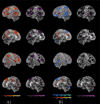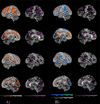Heritability of head motion during resting state functional MRI in 462 healthy twins
- PMID: 25132021
- PMCID: PMC4252775
- DOI: 10.1016/j.neuroimage.2014.08.010
Heritability of head motion during resting state functional MRI in 462 healthy twins
Abstract
Head motion (HM) is a critical confounding factor in functional MRI. Here we investigate whether HM during resting state functional MRI (RS-fMRI) is influenced by genetic factors in a sample of 462 twins (65% female; 101 MZ (monozygotic) and 130 DZ (dizygotic) twin pairs; mean age: 21 (SD = 3.16), range 16-29). Heritability estimates for three HM components-mean translation (MT), maximum translation (MAXT) and mean rotation (MR)-ranged from 37 to 51%. We detected a significant common genetic influence on HM variability, with about two-thirds (genetic correlations range 0.76-1.00) of the variance shared between MR, MT and MAXT. A composite metric (HM-PC1), which aggregated these three, was also moderately heritable (h(2) = 42%). Using a sub-sample (N = 35) of the twins we confirmed that mean and maximum translational and rotational motions were consistent "traits" over repeated scans (r = 0.53-0.59); reliability was even higher for the composite metric (r = 0.66). In addition, phenotypic and cross-trait cross-twin correlations between HM and resting state functional connectivities (RS-FCs) with Brodmann areas (BA) 44 and 45, in which RS-FCs were found to be moderately heritable (BA44: h(2) = 0.23 (sd = 0.041), BA45: h(2) = 0.26 (sd = 0.061)), indicated that HM might not represent a major bias in genetic studies using FCs. Even so, the HM effect on FC was not completely eliminated after regression. HM may be a valuable endophenotype whose relationship with brain disorders remains to be elucidated.
Keywords: Broca's area; Head motion; Heritability; Resting state fMRI; Twin study.
Copyright © 2014 Elsevier Inc. All rights reserved.
Figures



References
-
- Anokhin AP, Heath AC, Myers E, Ralano A, Wood S. Genetic influences on prepulse inhibition of startle reflex in humans. Neurosci Lett. 2003;353:45–48. - PubMed
-
- Arseneault L, Moffitt TE, Caspi A, Taylor A, Rijsdijk FV, Jaffee SR, Ablow JC, Measelle JR. Strong genetic effects on cross-situational antisocial behaviour among 5-year-old children according to mothers, teachers, examiner-observers, and twins' self-reports. J Child Psychol Psychiatry. 2003;44:832–848. - PubMed
-
- Ashburner J. A fast diffeomorphic image registration algorithm. Neuroimage. 2007;38:95–113. - PubMed
Publication types
MeSH terms
Grants and funding
LinkOut - more resources
Full Text Sources
Other Literature Sources
Molecular Biology Databases
Research Materials
Miscellaneous

